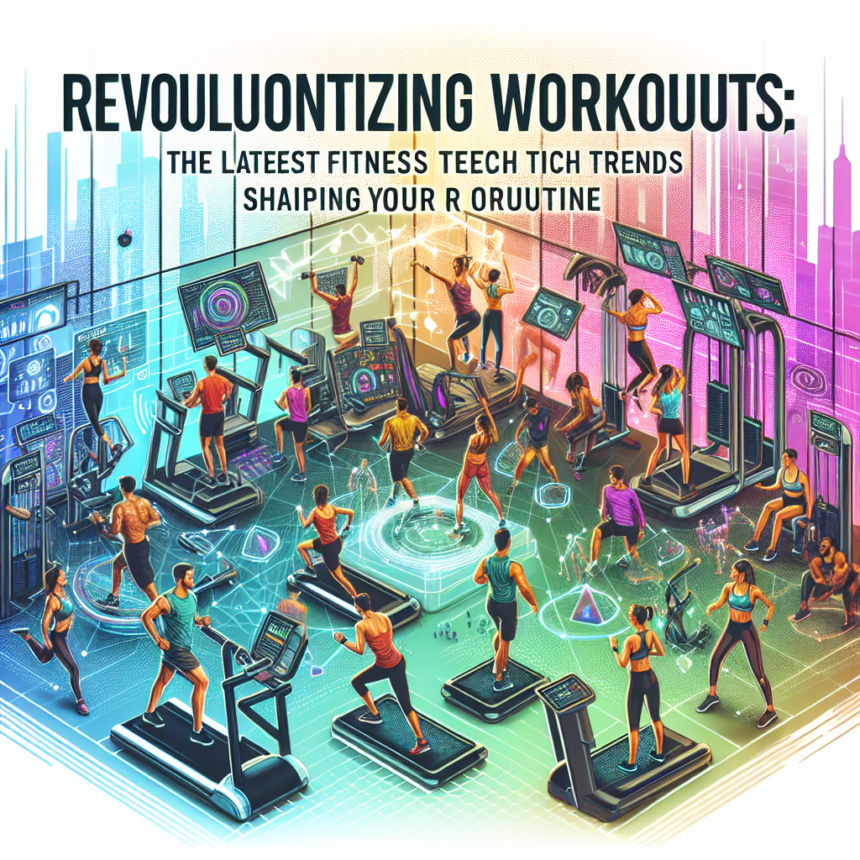In an age where technology permeates every facet of our lives, the fitness industry is experiencing a profound transformation. Gone are the days of simplistic workout routines and basic gym equipment. Fitness enthusiasts are now seamlessly integrating cutting-edge technologies into their training regimens to enhance performance, monitor progress, and maintain motivation. Here are some of the latest fitness tech trends that are revolutionizing workouts and shaping your fitness routine.
1. Smart Wearables
Wearable technology has come a long way from basic pedometers to sophisticated devices that can track a myriad of health metrics. Smartwatches and fitness trackers have evolved to measure heart rate, calories burned, VO2 max, and even sleep patterns. Brands like Fitbit, Garmin, and the Apple Watch lead this charge, providing users with real-time feedback that allows for more personalized workout regimens. These wearables not only keep you accountable but also empower you to understand your body better.
2. Virtual and Augmented Reality Workouts
The advent of Virtual Reality (VR) and Augmented Reality (AR) has changed the landscape of interactive workouts. Virtual reality platforms, such as Peloton and Oculus, offer immersive experiences where users can engage in cycling sessions with breathtaking environments and live instructors. Similarly, AR fitness apps like Zombies, Run! blend gaming with running, allowing users to "escape" from virtual zombies while completing their fitness goals. This innovation compels users to stay engaged and transform monotonous workouts into exhilarating experiences.
3. AI-driven Personal Training
Artificial Intelligence (AI) is making waves in the fitness world by offering tailored workout plans and nutrition guidance. Platforms like Freeletics and Fitbod utilize AI algorithms to assess your fitness level, goals, and preferences, creating a customized workout plan that evolves as you progress. These virtual trainers are always available, making it easy to access expert guidance without the need for a physical trainer. Moreover, by analyzing data from wearables, AI can provide insights to optimize performance and recovery.
4. Connected Equipment
Smart fitness equipment, such as Peloton bikes and Tonal strength trainers, has popularized the concept of connected workouts. These devices come equipped with screens for guided workouts, streaming capabilities, and performance tracking through smart integration. Users can join live classes, connect with friends, and follow along in real time from the comfort of their homes. This not only creates a community feeling but also ensures that users consistently challenge themselves with new workouts and routines.
5. Health and Fitness Apps
The surge in mobile applications dedicated to fitness, nutrition, and general wellness has democratized access to valuable resources and guidance. Apps like MyFitnessPal enable users to track their calorie intake, while others like Strava and Nike Training Club offer guided workouts and social sharing features. With an array of options, individuals can find apps that cater specifically to their fitness goals, be it weight loss, strength training, or overall wellness.
6. Recovery Technology
In recent years, recovery technology has garnered much attention, emphasizing the importance of rest in achieving fitness goals. Devices like the Theragun, a percussive therapy device, provide muscle relief through deep tissue massage. Additionally, products like Hyperice’s ice compression sleeves combine cold therapy with compression to reduce inflammation and speed up recovery time. These gadgets are now essential for athletes and fitness enthusiasts, ensuring optimum performance and preventing injury.
7. Home Gym Solutions
The pandemic accelerated the trend of creating home gyms, and innovative solutions emerged to facilitate this movement. Companies began offering compact, multifunctional equipment that could offer a full-body workout in limited space. Products like resistance bands, power towers, and adjustable dumbbells have made it easier than ever to engage in an effective workout at home, often aided by virtual class offerings and online communities for motivation.
Conclusion: Embrace the Future of Fitness
With the latest fitness tech trends revolutionizing workouts, achieving your fitness goals has never been more accessible or engaging. Whether through smart wearables, virtual classes, or AI-driven insights, technology empowers individuals to customize their workouts and prioritize health in meaningful ways. Embrace these innovations to transform your routine and achieve a healthier lifestyle.
FAQs
Q: What is the best fitness wearable for beginners?
A: Beginners should start with an easy-to-use fitness tracker like the Fitbit Inspire or a basic smartwatch like the Apple Watch SE, which both offer essential features without overwhelming complexity.
Q: Are virtual reality workouts effective?
A: Yes, VR workouts can be highly effective as they provide immersive experiences that can enhance motivation and engagement, leading to better adherence to fitness routines.
Q: How can AI improve my workout routine?
A: AI can analyze your fitness data to create personalized workout plans, suggesting exercises based on your progress and needs, ultimately guiding you toward your fitness goals more effectively.
Q: What are the benefits of smart home gym equipment?
A: Smart home gym equipment often provides guided workouts and data tracking, creating a more engaging experience while allowing users to maintain their fitness routine in a convenient setting.
Q: How important is recovery technology?
A: Recovery technology is crucial as it helps reduce muscle soreness and inflammation, allowing for a quicker return to workouts and minimizing the risk of injury.











